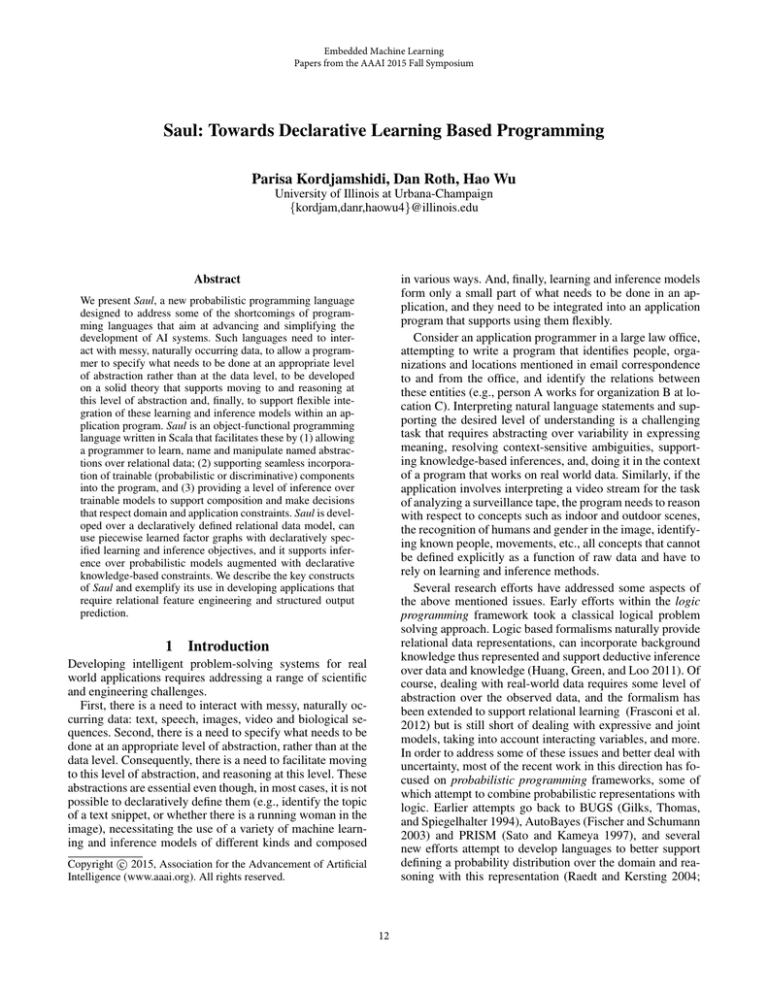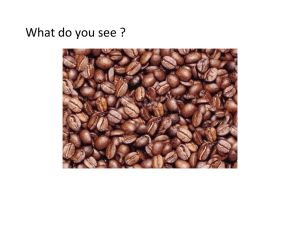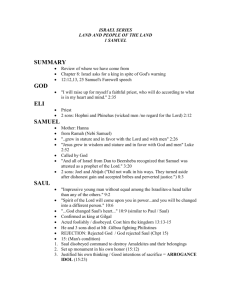
Embedded Machine Learning
Papers from the AAAI 2015 Fall Symposium
Saul: Towards Declarative Learning Based Programming
Parisa Kordjamshidi, Dan Roth, Hao Wu
University of Illinois at Urbana-Champaign
{kordjam,danr,haowu4}@illinois.edu
Abstract
in various ways. And, finally, learning and inference models
form only a small part of what needs to be done in an application, and they need to be integrated into an application
program that supports using them flexibly.
Consider an application programmer in a large law office,
attempting to write a program that identifies people, organizations and locations mentioned in email correspondence
to and from the office, and identify the relations between
these entities (e.g., person A works for organization B at location C). Interpreting natural language statements and supporting the desired level of understanding is a challenging
task that requires abstracting over variability in expressing
meaning, resolving context-sensitive ambiguities, supporting knowledge-based inferences, and, doing it in the context
of a program that works on real world data. Similarly, if the
application involves interpreting a video stream for the task
of analyzing a surveillance tape, the program needs to reason
with respect to concepts such as indoor and outdoor scenes,
the recognition of humans and gender in the image, identifying known people, movements, etc., all concepts that cannot
be defined explicitly as a function of raw data and have to
rely on learning and inference methods.
Several research efforts have addressed some aspects of
the above mentioned issues. Early efforts within the logic
programming framework took a classical logical problem
solving approach. Logic based formalisms naturally provide
relational data representations, can incorporate background
knowledge thus represented and support deductive inference
over data and knowledge (Huang, Green, and Loo 2011). Of
course, dealing with real-world data requires some level of
abstraction over the observed data, and the formalism has
been extended to support relational learning (Frasconi et al.
2012) but is still short of dealing with expressive and joint
models, taking into account interacting variables, and more.
In order to address some of these issues and better deal with
uncertainty, most of the recent work in this direction has focused on probabilistic programming frameworks, some of
which attempt to combine probabilistic representations with
logic. Earlier attempts go back to BUGS (Gilks, Thomas,
and Spiegelhalter 1994), AutoBayes (Fischer and Schumann
2003) and PRISM (Sato and Kameya 1997), and several
new efforts attempt to develop languages to better support
defining a probability distribution over the domain and reasoning with this representation (Raedt and Kersting 2004;
We present Saul, a new probabilistic programming language
designed to address some of the shortcomings of programming languages that aim at advancing and simplifying the
development of AI systems. Such languages need to interact with messy, naturally occurring data, to allow a programmer to specify what needs to be done at an appropriate level
of abstraction rather than at the data level, to be developed
on a solid theory that supports moving to and reasoning at
this level of abstraction and, finally, to support flexible integration of these learning and inference models within an application program. Saul is an object-functional programming
language written in Scala that facilitates these by (1) allowing
a programmer to learn, name and manipulate named abstractions over relational data; (2) supporting seamless incorporation of trainable (probabilistic or discriminative) components
into the program, and (3) providing a level of inference over
trainable models to support composition and make decisions
that respect domain and application constraints. Saul is developed over a declaratively defined relational data model, can
use piecewise learned factor graphs with declaratively specified learning and inference objectives, and it supports inference over probabilistic models augmented with declarative
knowledge-based constraints. We describe the key constructs
of Saul and exemplify its use in developing applications that
require relational feature engineering and structured output
prediction.
1
Introduction
Developing intelligent problem-solving systems for real
world applications requires addressing a range of scientific
and engineering challenges.
First, there is a need to interact with messy, naturally occurring data: text, speech, images, video and biological sequences. Second, there is a need to specify what needs to be
done at an appropriate level of abstraction, rather than at the
data level. Consequently, there is a need to facilitate moving
to this level of abstraction, and reasoning at this level. These
abstractions are essential even though, in most cases, it is not
possible to declaratively define them (e.g., identify the topic
of a text snippet, or whether there is a running woman in the
image), necessitating the use of a variety of machine learning and inference models of different kinds and composed
c 2015, Association for the Advancement of Artificial
Copyright Intelligence (www.aaai.org). All rights reserved.
12
used as a way to incorporate expressive prior knowledge
into the models and bias the assignments made by the
learned models. When joint learning is done for a piece of
the network, learning follows the constraint-driven learning
(CODL) (Chang, Ratinov, and Roth 2007) or posterior regularization (Ganchev et al. 2010; Samdani, Chang, and Roth
2012) paradigms.
This programming paradigm allows one to think at the
problem formulation level and incorporate domain and application specific insights in an easy way. The corresponding programming framework thus supports integrated learning and reasoning via (soft) constrained optimization; this
allows for making decisions in an expressive output space
while maintaining modularity and tractability of training and
inference. This ability of Saul is augmented with its data
modeling language: a declarative language via which the
programmer can declare the relational schema of the data.
This is used to support flexible structured model learning
and decision making with respect to a customizable objective function.
Saul is intended to have some elements of automatic programming, by supporting programming by default at several
steps of the computation. Once the programmer defines the
data model by specifying what can be seen in the given data,
and defines a set of variables of interest that will be assigned
values, a default set of models can be learned and tuned automatically from data, and global inference done via a default objective function supports making coherent decisions
that agree with the declared interdependencies among output
variables. The programmer can then choose to further refine
the data model, the structured model and the training and inference paradigms via declarative constructs, providing high
level guidance for relational feature engineering, decomposing training and inference, or combining models. This way,
Saul separates the layer of designing models from that of the
underlying code for learning and inference and supports embedding sophisticated learning and inference models within
application code in a seamless way.
In the rest of this paper we provide a motivating example exhibiting the advantages of Saul programming, sketch
some of the key abstractions and relational representations
that underlie it, and discuss the underlying probabilistic
paradigm supporting learning and inference of structured
models, along with composition, nesting and pipelining. We
conclude with a discussion of the prospects of the Saul language.
Goodman et al. 2008; Pfeffer 2009; Mansinghka, Selsam,
and Perov 2014). Some of these languages are equipped
with relational languages to facilitate the design of complex
probabilistic models declaratively (Domingos and Richardson 2004) or imperatively (McCallum, Schultz, and Singh
2009). However, in all cases, these efforts focus on flexibly defining one joint probability distribution. They do not
intend to support the development of applications that require combining, nesting and pipelining multiple models
and running inference over these, nor to support the need
to flexibly mix deterministic and probabilistic models (Mateescu and Dechter 2008). Moreover, current probabilistic
programming languages do not address the desiderata outlined earlier and do not support the natural work flow of
developing applications from the interaction with real world
data, through learning models and combining them in different ways, to making coherent, global, decisions over a large
number of variables with a range of interaction patterns.
We present Saul, a new probabilistic programming language designed to address all the desiderata of a Learning
based program (Roth 2005). Saul is an object-functional
programming language written in Scala (Odersky, Spoon,
and Venners 2008), that supports declarative definitions of
trainable probabilistic or discriminative models and embedding them in programs, along with declarative definitions
of inference patterns and objective functions over trainable
models. This way it allows the development of programs that
interact with real world data, allowing a programmer to abstract away most of the lower level details and reason at the
right level of abstraction.
Saul can be viewed as a significant extension of an existing instance of the LBP framework, LBJava (Rizzolo
and Roth 2010), where learned classifiers, discriminative
or probabilistic, are first class objects, and their outcome
can be exploited in performing global inference and decision making at the application level. However, in addition
to these features, Saul supports joint learning and inference with structured outputs. From a theoretical perspective
Saul’s underlying models are general factor graphs (Kschischang, Frey, and Loeliger 2001) extended to relational representations (Taskar, Abbeel, and Koller 2002) and expressing
constrained factors (Cunningham, Paluri, and Dellaert 2010;
Martins 2012) with directional semantics to represent various learning and inference architectures. This expressive
power provides the possibility of mapping a Saul program
to underlying mixed networks (Mateescu and Dechter 2008)
that can consider both deterministic and probabilistic information. The inferences supported by Saul are all (extensions
of) maximum a posteriori (MAP) inferences formulated,
without loss of generality, as integer linear programs (Roth
and Yih 2007; Sontag 2010), even though some of the inference engines within Saul may not perform exact ILP.
Learning and inference in Saul follows the Constrained
Conditional Models (CCMs) (Chang, Ratinov, and Roth
2012) paradigm, allowing MAP inference over jointly or
piecewise learned networks (Heckerman et al. 2000; Roth
and Yih 2005). The CCM framework augments learning
and inference with conditional (probabilistic or discriminative) models, with declarative constraints. Constraints are
2
Saul: The Language Components
In this section we provide an overview of the main constructs
of the language. The Saul language has been implemented as
a domain specific language (DSL) within Scala to easily provide Turing-complete functionality, as well as the possibility
of exploiting the most recent advancements in programming
languages and integrated development environments (IDEs).
This paper exemplifies Saul components using the Entitymention-Relation1 extraction task which aims at identifying
1
Note that the terms entity and relation are overloaded and are
used both to refer to named entities and semantic relations between
13
named entities of types person, location, organization and
relations of types lives-in, works-for, in a given text. For this
application, Saul is given as input free form text, and the
programmer then writes a program that makes use of the
identified named entities and relations. Within Saul, some
components of the code are devoted to training models and
instructing Saul on how to make decisions (inferences) –
how to decide what entities and relations are present in a
given text. For the sake of training, Saul is given as input
annotated data, where text is augmented with the identified
named entities and the identified relations of the aforementioned types. The rest of this article is devoted mostly to describing how Saul deals with annotated data, but it is important to realize that, in the end, Saul allows the programmer
to develop an application in which these learned models and
decision paradigms are first class objects.
A Saul program includes two main types of declarations
to support problem solving: (i) data and knowledge representation, and (ii) learning and inference model declarations.
In the standard machine learning setting, models are trained
given a set of labeled examples. In Saul, an example consists
of two sets of instantiated variables; a set of observed variables, which will be present in future observation at runtime
(when the trained models are used on “real” data), and a set
of variables of interest, to which we want to assign values,
and which are instantiated only in the training data. A Saul
program interacts with the original datasets which we refer
to as Collections of data. These collections give rise to examples, represented as feature vectors, which are generated
automatically given declarations provided by the programmer. Flexible relational Feature declarations constitute an
important part of the Saul language.
In addition to the information that comes from the Collections of data, the programmer can express higher level Background knowledge that could relate assignments to variables
Saul observes or assigns values to. This is represented in a
first-order-like logical language that Saul makes use of automatically, either in the feature extraction stage or at the
learning and inference step, as a way to bias a learned model
toward or away from some variable assignments. In addition
to declare how raw data collections are transformed into the
internal Saul representation, the programmer makes use of
Learning declarations and Inference declarations. The former allow the programmer to define which variable(s) will
be represented as learned functions of other variables (observed or not). The programmer can resort to strong defaults
once the basic definitions are set, but Saul provides the flexibility of designing various training models and composing
them to train local models, global models or pipelines, as
will be clear in Sec 4. In particular, the learning process
may follow different strategies during training and at runtime evaluation, as declared by the programmer. The Inference declarations determine how decisions (predictions)
are made, and what interdependencies among variables are
taken into account when making decisions.
Learning and Inference in Saul are facilitated by an underlying data model that accommodates all the data and knowl-
W. Dale Nelson covers the White House for the Associated Press.
name: lexical form
value: W. Dale
Nelson
type: Phrase
PI: p1
Pairs
Has-Label
Person
name: lexical form
value: covers
type: Phrase
PI: p2
Pairs
name: distance
value: 6/7
type: Phrase
PI: p3
Pairs
name: lexical form
value: Associated
Press
...
type: Phrase
PI: p4
Pairs
Has-Label
Has-Label
WorksFor
Organization
Figure 1: A part of the data graph; this is a propositionalized graph containing the complete instances as observed by
Saul; rectangles show entities, diamonds show relationships
and ovals show properties.
edge in a unified relational framework and provides efficient and flexible access to all pieces of information about
the problem. Hence, a part of the underlying infrastructure
of the Saul language depends on determining and declaring
(and evolving) the relational schema of the data.
3
Data and Knowledge Representation
The Saul language provides the programmer easy communication with heterogeneous, real world data. To facilitate the
use of various types of data and exploit its structure, we use
a graphical representation that serves as a unified model for
all the data used by a Saul program. We represent the data
using two different but related graphs: data graph and model
graph (Ghrab et al. 2013).
The data graph encodes the propositional information
given in the individual (annotated) instances provided to
Saul – it encodes what the program can “see” in the given
data. The representation consists of three kinds of nodes: entity nodes, relationship nodes and property nodes, and edges
that connect various nodes. An example of the data graph
for the Entity-mention-Relation task is shown in Figure 1.
The model graph, on the other hand, is a first order graph
that represents the relational schema of the data. The nodes
in this graph indicate the types (for both entities and relationships) and the edges that connect the various types of
nodes to each other. Edges have a degree that indicates a
property of the relation (i.e., 1:1, 1:n or n:n).
The model graph in Figure 2, shows entities of type Word
and Phrase and the Contains relationship between them.
The words can have a nextTo relationship with each other.
Each phrase contains a number of words. The phrases are
related to each other by a Pairs relationship. This graph
also represents the nodes that constitute the target variables,
those variables we want to eventually assign values to in the
Entity-mention-Relation task, and their assumed dependencies on input nodes. This connection is represented by relationship nodes of type Has-label, that indicate the range of
each variable; Has-label is also being used to indicate the
range of relationship nodes such as Pairs. E.g., it indicates
that a pair of entity nodes could take the type WorkFor.
them in our example, and to elements in Saul’s data model.
14
Sentence
Contain
nextTo
Pairs
Phrase
Has-Label
Has-Label
tion languages (Cumby and Roth 2003). The classic Join,
Project and Select operations and the logical combinations
of these operators thus support evolving the data and model
graphs.
Word
Contain
3.2
Person
WorksFor
Organization
Figure 2: A part of the model graph of the Entity-mentionRelation task. We show the entities and relationships with
double line indicating the classes of instances in contrast to
the data model representation. The arrows show the degree
of relationships in each direction.
val EntityFeatures = FeaturesOf[Phrase] {
x:Phrase=>{ pos(x)::lexForm(x)::lemma(x)::
lemma(x.next())::pos(x.window(2))::Nil}}
Real world data supplied to Saul is assumed to be a dataset
consisting of similar data items (e.g., a collection of text
documents). Saul assumes that datasets come along with a
Reader, a program that reads data into the aforementioned
data graph. Note that the reader needs to read annotated data
(and form a complete data graph that can be used by Saul to
train models), but also runtime data that is not annotated and
forms a partial data graph, in which some of the variables
are not instantiated. Also note that the reader itself could be
a Saul program, and use sophisticated models to generate the
data graph. The description of Saul in the rest of this paper
assumes the graph representations described above as input.
3.1
Relational Features and Graph Queries
In the classical learning setting, information about a problem
is represented using feature vectors representing the examples. Each learning example in Saul is a rooted subgraph of
the data graph and the features for each example are directly
derived from properties of the entities and relationships in
the data graph and the sensor applied to them. Namely, each
feature is an outcome of a query that extracts information
from the data graph or from sensors. This can be viewed as
an extension of relational feature extraction languages such
as (Cumby and Roth 2003). A Saul programmer can simply
list the graph queries he/she wants to use as feature “types”
and these will be instantiated in the data graphs. The code
excerpt below exhibits this for features of the type Phrase.
This one line of code declares a list of queries from the
data graph for retrieving the properties of an object of type
Phrase in the model graph. The list includes the linguistic features of posTags, lemma, lexical form, in addition
to a contextual feature which is the lemma of the adjacent Phrase, using the function next and the posTag of the
phrases in a window with length 2 around that phrase.
Any Scala expression built on the graph queries can be
used as a feature, and a programmer can always define a
complex feature, name it, and use it in further definitions.
Moreover, Saul is rich in defaults, and allows the programmer to not define features, in which case all properties based
on the model graph declarations are used as default features.
Graph Evolution
One important idea supported by Saul that, in turn, facilitates some of Saul properties, is that of building new layers of abstraction from the raw data and subsequently learning and inference with more expressive models in terms of
these. Saul provides ways to generate new nodes and edges
in the graphs, via Saul’s learned models, given the initial
data graph provided by the Readers. We use the term functor
to refer to a function F : {τ } 7→ {τ 0 }, that maps one or more
typed collection to one or more new typed collection. The
functors make changes to the data graph, that could also impact the model graph, by providing richer and more expressive vocabulary for the programmer to use. The graphs can
evolve using two types of functors: extractors and sensors.
Sensors are arbitrary functions that have external sources of
information outside the data graph and the information that
the Readers can provide directly. Their computational mechanism is a black box for the Saul language and they can
be viewed as determining what Saul can “see” in the data
(a “word”, “prefix”, etc.). Extractors are Saul programs that
act on the information contained in the data graph and make
use of the background knowledge representation, described
in the next section, to generate new information by doing
inference. Saul consists of a relational calculus that can be
used over the sensors and extractors to generate other sensors and extractors, in a way similar to other Feature Extrac-
3.3
Representing Background Knowledge
The model graph represents the concepts, their properties
and the relationships between them but, often, it is important
to represent higher level information; for example, to express expectations over the output predictions (Chang, Ratinov, and Roth 2007; Ganchev et al. 2010). These are often
hard to express using the graph only, wasteful to try to acquire directly from the data, and an expressive declarative
language could be easier and intuitive to use. Of course, exploiting this knowledge requires particular attention in both
representation and learning and Saul builds on rich literature
that guides us how to do it.
Considering relations between variables in the input
boils down to representing input features and is relatively
standard. However, encoding knowledge about interactions
among output variables is more challenging. Saul can induce these interactions automatically in the learning process but, importantly, also supports expressing these declaratively, as constraints. These constraints are represented using first-order-like logical language that also supports quantifiers, allowing a programmer to easily express constraints,
as in the example below, to indicate that the value predicted
15
In the standard structured learning framework, this objective is assumed to be a linear discriminant function in terms
of the combined feature representation of inputs and outputs
f , that is, g = hW, f (x, y)i, where W is a weigh vector
representing the parameters of the linear model. By explicitly representing the relational, declarative knowledge that
captures global characteristics of the model and (expectations of) constraints over output space assignments, objectives used in Saul are formulated, as a constrained conditional model (CCM) (Chang, Ratinov, and Roth 2012):
for the relation between two argument variables constrains
the values that could be assigned to arguments.
val WorkFor=constraintOf[Pairs] {
x:Pairs => {
((WorkFor on x) is true) ==>
((PER on x.firstArg) is true) &&&
((WorkFor on x) is true) ==>
((ORG on x.secondArg) is true) } }
Here, for the input pair x=(firstArg,secondArg), if
firstArg and secondArg have the WorkFor relationship
then secondArg should be an organization (ORG) and
firstArg a person (PER). Via our defined constraintOf
template, Saul compiles this declarative representation to
a set of equivalent linear constraints automatically and efficiently (Rizzolo and Roth 2010)), and this is used as part
of the objective function discussed later. It is important to
note that while the constraints are represented declaratively,
Saul’s learning and inference paradigms allow using them
either as hard or soft constraints (Chang, Ratinov, and Roth
2012). As has been shown repeatedly in the literature over
the last few years, this capability, which is simply encoded
as a single construct in Saul, provides a unique flexibility
for using background knowledge both in feature generation (e.g., as part of a pipeline process) and for constraining
global inference.
g = hW, f (x, y)i − hρ, c(x, y)i,
(1)
where c is a constraint function and ρ is a vector of penalties
for violating each constraint. A Saul factor graph thus corresponds to a general CCM objective that can be used in training probabilistic graphical models as well as generalized linear models (Roth and Yih 2005). When the constraints in
the objective are treated as hard constraints it directly corresponds to an integer linear program, and thus can be used to
encode any MAP problem. Specifically, the g function can
be represented as the sum of local joint feature functions
which are the counterparts of the probabilistic factors:
g(x, y; W ) =
X X
hWp , fp (xk , lpk )i +
lp ∈l xk ∈{τ }
|C|
X
ρm cm (x, y)
m=1
(2)
4
Learning and Inference
where x and y are subgraphs of the data graph, and each fp
is a local joint feature function applied on a type τ (i.e. a
model graph node) when it is relevant for the output node of
type lp ∈ l; l is a set of output type nodes. In other words,
each fp is a relational clique template (Taskar, Abbeel, and
Koller 2002) based on the types of input and output that it
takes. However, g can be decomposed and learned in other
ways to represent a more general scoring function than the
one corresponding to the likelihood of an assignment.
In Saul, each relational factor fp is declared as a classifier (Heckerman et al. 2000; Roth and Yih 2005; Sutton and
McCallum 2005). In other words, a classifier is a relational
clique template, with a set of features that are applied on a
type of input and output nodes in the model graph. Each factor is a learning model defined declaratively as a Scala object
using the following Learnable template (for example):
The key innovations in Saul are in the learning and inference
models – the representations used, the formulations facilitated and the flexibility within which an Saul programmer
can declare, learn, and make decisions with a range of learning and inference paradigms.
The underlying representation of a Saul program is a general factor graph. This provides the expressivity of different
kinds of probabilistic and discriminative models (Kschischang, Frey, and Loeliger 2001; Collins 2002; Roth and Yih
2005) and hence the possibility of using a variety of algorithms for learning and inference. The Saul factor graphs are
significantly augmented to facilitate:
• Representing relational factors (Taskar, Abbeel, and
Koller 2002),
• Representing constraint factors (Martins 2012; Cunningham, Paluri, and Dellaert 2010),
object ORG extends Learnable[Phrase] {
def label = entityType is "Organization"
def features=EntityFeatures}
• Representing directional computation with Saul specific
semantics.
This classifier corresponds to factor 1 in Figure 3-a and 3-b.
Other factors can be defined in a similar way. The constraint
factors are Saul’s first order logical expressions, shown as
black boxes in Figure 3-b. The code of factor 5 in this figure was presented in Section 3.3. It bounds the labels of
type ORG, PER and WorkFor to each other. Factor 4 can be
declared as follows, using Saul’s constraintOf definition
Scala template:
The goal of this extension is to increase the expressivity of
the standard factor graphs, support more expressive modeling architectures for learning and inference, and provide the
most modularity and flexibility to the Saul programmer.
The training process in Saul can be formulated, without loss of generality, as follows: given a set of N inputoutput pairs of training examples with any arbitrary structure E = {(xi , y i ) ∈ X × Y : i = 1..N }, find a function
g(x, y; W ) that assigns a score to a pair of input and output. Function g is the objective function, that is then used to
make a prediction: given x, it predicts the best scoring y.
val SingleEntityLabel=constraintOf[Phrase]{
x:Phrase=>{
((PER on x) is true)==>((ORG on x) is false
) &&&
16
Phrase
Phrase
1
2
ORG
PER
(a)
3
Phrase
Phrase
Phrase
1
2
ORG
PER
Phrase
object WorkForCCM extends
ConstraintClassifier[Pairs]{
def subjectTo= WorkFor }
Phrase
3
This one line of code automatically recalls the factors/feature templates related to these target models in the WorkFor
constraint, builds an appropriate objective function and optimizes it. Given this declaration, later in the program, the programmer can call WorkForCCM(obj) to make a joint prediction for an input object of type P air and its arguments.
Joint training. To use all the connections in the factor graph
of figure 3-b, the same CCM object of the previous example
can be invoked and used during training, in an inferencebased training (IBT) setting for structured learning. Training
joint models, as in the joint prediction above, only requires
the programmer to define the way the outputs of the variables of interest are related to each other. This can be done,
for example, via this learning model:
Works
For
(b)
Phrase
Works
For
4
5
Figure 3: a) the FG of a pipeline model, b) the FG of a joint
model in which the labels are related with constraint factors.
((ORG on x) is true)==>((PER on x) is false
)}}
This constraint imposes the assignment of only one entitymention type to each phrase. These declarations or a subset
of them can be used in an Saul program to compose a spectrum of models from very local models up to more global
(but decomposed) and fully joint models.
4.1
object WorkForJoint extends
ConstraintLearner[Pairs]{
def subjectTo= WorkFor }
Model Composition
Basically, the same objective that was created earlier for
making predictions is created now during the training and
the parameters of the all (simpler) learning models involved,
(here, for PER, ORG, WorkFor) are updated jointly in an
inference-based training fashion (Chang, Ratinov, and Roth
2007). The learning models that have been trained jointly,
can used later by the programmer for making predictions in
any arbitrary configuration.
Pipeline models. The most commonly used models in many
applications including natural language processing tasks, are
pipeline models. Saul’s local learning models can be used
in a pipeline system in a straight forward way to support
complex decisions based on local decisions made in earlier
layers of the pipeline. A named model can be called by its
name to assign a label to an input object. Thus, variables
that were learned in the Saul program can be naturally used
as features of other learning models in the same program.
For example, we can call PER.learn() and ORG.learn()
to train two independent models and then define the features
for the WorkFor learner as follows:
Now that we have discussed how each factor is expressed in
a Saul program, we describe how these factors can be easily composed and chained in various configurations, resulting in different models. Saul allows a programmer to easily
compose complex models using the relational factors and
the constraint factors. The terminology used to describe the
various models is taken from (Punyakanok et al. 2005), but
our models are more general than those described there.
Local models (LO). Each relational clique template fp can
be defined as a local classifier such as the above ORG object
using the Saul’s Learnable template, and trained independently2 . In figure 3-b if we ignore the factors 4 and 5 we will
have three independent local models. Training these models is simply done by adding the data, that comes form the
reader in collections to the data graph and running a line
such as, ORG.learn(), or test a classifier using ORG.test
() for the classifier ORG, in this case. The collection of
test data can be passed explicitly to the test function too.
A trained model is a named object that returns a prediction
for the relevant objects. of figure 3-b
Local learning and global prediction (L+I). In many real
world situations, training a complex model can be decomposed into independently training a number of local models
(Besag 1977; Heckerman et al. 2000; Roth and Yih 2005;
Sutton and McCallum 2005; Samdani and Roth 2012), but
it can gain an advantage from a joint, constrained, prediction using the trained local models. In Saul this requires the
programmer to only declare how the outputs of decomposed
models (target variables) are related to each other. For example, the three classifiers of the entities PER, ORG and
WorkFor can be trained locally, by calling the learn function for each. To predict globally, the programmer will write
the following constraint conditional classifier:
val RelationFeatures = FeaturesOf[Pair]{
x:Pair=>{ORG(x.firstArg)::PER(x.secondArg)::
lexForm(x.firstArg)::Nil}}
This feature declaration defines a list of features, two of
which, ORG and PER, are Saul models themselves:
Object WorkForPipe extends Learnable[Pair]{
def label = retype is "Work-For"
def features=RelationFeatures}
This model is represented in the factor graph in Figure 3-b.
This example also clarifies the semantics of the directions
on the arrows of the Saul factor graphs. These arrows show
the direction of the computations; having only one direction
means that the model is decomposed and components are
then pipelined. Defining complex pipeline models does not
need any additional programming effort in Saul.
2
Setting specific algorithms’ parameters can be done by the programmer, or automatically by Saul; these details are omitted.
17
Approach
LO
L+I
Pipeline
Pipeline+I
Joint (IBT)
PER
77.71
78.57
77.71
77.94
78.88
ORG
72.56
72.46
72.56
72.32
71.15
LOC
83.51
83.69
83.51
83.67
81.60
WorkFor
60.99
57.97
52.06
50.59
69.00
LiveIn
54.88
60.75
62.57
65.60
69.48
minimal coding in Saul, that could have taken significantly
more effort in conventional programming languages. Saul
is designed over an expressive data and modeling representation, as a high level and very easy to use language, thus
promising to advance our thinking on how to better model
and develop learning based programs in AI.
Table 1: The F1 of various models architectures including
local, global, pipeline models with different training and
prediction configurations which are designed in Saul, 5-fold
cross validation, CoNLL-04 dataset
4.2
6
Experimental Results
In order to exemplify the ease within which Saul allows one
to develop expressive models, we designed a set of experiments, expanding on (Roth and Yih 2007). Table 1 shows
the experimental results of running the learning and inference models described in Section 4.1 on the CoNLL-04 data
for the Entity-mention-Relation (see Section 3). The applied
features are designed in Saul based on the previous literature
and inference includes the WorkFor constraint described in
Section 3.3, a similar constraint for the LiveIn relation,
the SingleEntityLabel constraint, defined in Section 4,
which allows only one label per entity and a similar one for
relations.
The goal of this experiment is not to show improved results, but rather exhibit the fact that a preliminary implementation of Saul is already functional and, most importantly,
that minor variation to the Saul code, as shown above, already yield powerful results.
In addition to the models of Section 4.1, we experimented
with another variation, Pipeline+I, that trains models in a
pipeline fashion but makes a prediction using global inference. The results indicate that in this problem, particularly
for predicting the relations, the joint training setting with
global predictions is the best setting. The results show that
for the entities, all settings are fairly similar, though joint
training slightly decreases F1 of the entities due to a drop
in recall. The joint training (IBT) shows its advantage in
the prediction of the relationships, WorkFor and LiveIn, for
which F1 has sharply increased compared to all other models.
5
References
Besag, J. E. 1977. Efficiency of pseudolikelihood estimation
for simple Gaussian fields. Biometrika 64(3):616–618.
Chang, M.; Ratinov, L.; and Roth, D. 2007. Guiding semisupervision with constraint-driven learning. In Proc. of the
Annual Meeting of the Association for Computational Linguistics (ACL), 280–287. Prague, Czech Republic: Association for Computational Linguistics.
Chang, M.; Ratinov, L.; and Roth, D. 2012. Structured learning with constrained conditional models. Machine Learning
88(3):399–431.
Collins, M. 2002. Discriminative training methods for hidden Markov models: Theory and experiments with perceptron algorithms. In Proceedings of the Conference on Empirical Methods for Natural Language Processing (EMNLP).
Cumby, C., and Roth, D. 2003. On kernel methods for relational learning. In Proc. of the International Conference on
Machine Learning (ICML), 107–114.
Cunningham, A.; Paluri, M.; and Dellaert, F. 2010. Ddfsam: Fully distributed slam using constrained factor graphs.
In Intelligent Robots and Systems (IROS), 2010 IEEE/RSJ
International Conference on, 3025–3030.
Domingos, P., and Richardson, M. 2004. Markov logic:
A unifying framework for statistical relational learning. In
ICML’04 Workshop on Statistical Relational Learning and
its Connections to Other Fields, 49–54.
Fischer, B., and Schumann, J. 2003. Autobayes: a system for
generating data analysis programs from statistical models.
Journal of Functional Programming 13(3):483–508.
Frasconi, P.; Costa, F.; De Raedt, L.; and De Grave, K. 2012.
kLog: a language for logical and relational learning with kernels. CoRR abs/1205.3981.
Ganchev, K.; Graça, J.; Gillenwater, J.; and Taskar, B. 2010.
Posterior regularization for structured latent variable models. Journal of Machine Learning Research.
Ghrab, A.; Skhiri, S.; Jouili, S.; and Zimnyi, E. 2013. An
analytics-aware conceptual model for evolving graphs. In
Data Warehousing and Knowledge Discovery, volume 8057
of LNCS. Springer Berlin Heidelberg. 1–12.
Conclusion
3
We presented Saul , a new probabilistic programming language within the Learning based programming family. The
language was designed to support, advance and simplify the
development of AI systems. We described the key components of this object-functional programming language and
argued that it allows a programmer to represent data and
knowledge, to learn, name and manipulate named abstractions over relational data, support the incorporation of first
order logical constraints and trainable components into the
program, and provide a level of inference over trainable
models to support a rich set of model chaining and composition. We showed some experimental results achieved by
3
Acknowledgments
This research was supported by grant 1U54GM114838
awarded by NIGMS through funds provided by the
trans-NIH Big Data to Knowledge (BD2K) initiative
(www.bd2k.nih.gov) and by DARPA under agreement number FA8750-13-2-0008. The content, views and conclusions
contained herein is solely the responsibility of the authors
and does not necessarily represent the official views of the
NIH, DARPA nor the U.S. Government.
http://cogcomp.cs.illinois.edu/page/software view/Saul
18
Roth, D. 2005. Learning based programming. Innovations
in Machine Learning: Theory and Applications.
Samdani, R., and Roth, D. 2012. Efficient decomposed
learning for structured prediction. In Proc. of the International Conference on Machine Learning (ICML).
Samdani, R.; Chang, M.; and Roth, D. 2012. Unified expectation maximization. In Proc. of the Annual Conference of
the North American Chapter of the Association for Computational Linguistics (NAACL).
Sato, T., and Kameya, Y. 1997. Prism: A language for
symbolic-statistical modeling. In Proceedings of the International Joint Conference on Artificial Intelligence (IJCAI),
1330–1339.
Sontag, D. 2010. Approximate Inference in Graphical Models using LP Relaxations. Ph.D. Dissertation, Massachusetts
Institute of Technology.
Sutton, C. A., and McCallum, A. 2005. Piecewise training
for undirected models. In UAI, 568–575. AUAI Press.
Taskar, B.; Abbeel, P.; and Koller, D. 2002. Discriminative
probabilistic models for relational data. In Proceedings of
the Eighteenth Conference on Uncertainty in Artificial Intelligence, 485–492.
Gilks, W. R.; Thomas, A.; and Spiegelhalter, D. J. 1994. A
language and program for complex bayesian modelling. The
Statistician 43(1):169–177.
Goodman, N. D.; Mansinghka, V. K.; Roy, D. M.; Bonawitz,
K.; and Tenenbaum, J. B. 2008. Church: A language for
generative models. In UAI, 220–229.
Heckerman, D.; Chickering, D. M.; Meek, C.; Rounthwaite,
R.; and Kadie, C. M. 2000. Dependency networks for inference, collaborative filtering, and data visualization. Journal
of Machine Learning Research 1:49–75.
Huang, S. S.; Green, T. J.; and Loo, B. T. 2011. Datalog and
emerging applications: An interactive tutorial. In Proceedings of the 2011 ACM SIGMOD International Conference
on Management of Data, 1213–1216. ACM.
Kschischang, F.; Frey, B.; and Loeliger, H. 2001. Factor
graphs and the sum-product algorithm. Information Theory,
IEEE Transactions on 47(2):498–519.
Mansinghka, V. K.; Selsam, D.; and Perov, Y. N. 2014.
Venture: a higher-order probabilistic programming platform
with programmable inference. CoRR abs/1404.0099.
Martins, A. F. T. 2012. The geometry of constrained structured prediction: applications to inference and learning of
natural language syntax. Ph.D. Dissertation, Universidade
Tecnica de Lisboa (Instituto Superior Tecnico) and Carnegie
Mellon University.
Mateescu, R., and Dechter, R. 2008. Mixed deterministic
and probabilistic networks. Annals of Mathematics and Artificial Intelligence 54(1-3):3–51.
McCallum, A.; Schultz, K.; and Singh, S. 2009. FACTORIE: Probabilistic Programming via Imperatively Defined
Factor Graphs. In The Conference on Advances in Neural
Information Processing Systems (NIPS).
Odersky, M.; Spoon, L.; and Venners, B. 2008. Programming in Scala: A Comprehensive Step-by-step Guide. USA:
Artima Incorporation, 1st edition.
Pfeffer, A. 2009. Figaro: An object-oriented probabilistic programming language. Technical report, Charles River
Analytics.
Punyakanok, V.; Roth, D.; Yih, W.; and Zimak, D. 2005.
Learning and inference over constrained output. In Proc. of
the International Joint Conference on Artificial Intelligence
(IJCAI), 1124–1129.
Raedt, L. D., and Kersting, K. 2004. Probabilistic logic
learning.
Rizzolo, N., and Roth, D. 2010. Learning based java for
rapid development of nlp systems. In Proc. of the International Conference on Language Resources and Evaluation
(LREC).
Roth, D., and Yih, W. 2005. Integer linear programming
inference for conditional random fields. In Proc. of the International Conference on Machine Learning (ICML), 737–
744.
Roth, D., and Yih, W. T. 2007. Global inference for entity
and relation identification via a linear programming formulation. In Getoor, L., and Taskar, B., eds., Introduction to
Statistical Relational Learning. MIT Press.
19






